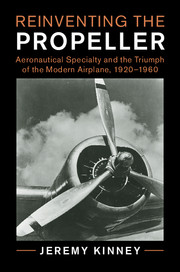Book contents
- Frontmatter
- Dedication
- Contents
- List of Figures
- List of Tables
- Preface
- Acknowledgments
- List of Abbreviations
- A Note on Terms
- 1 Introduction: The Propeller and the Modern Airplane
- 2 “The Best Propeller for Starting Is Not the Best for Flying”
- 3 “Engineering of a Pioneer Character”
- 4 A “New Type Adjustable-Pitch Propeller”
- 5 “The Propeller That Took Lindbergh Across”
- 6 “The Ultimate Solution of Our Propeller Problem”
- 7 No. 1 Propeller Company
- 8 A Gear Shift for the Airplane
- 9 Constant-Speed
- 10 “The Spitfire Now ‘Is an Aeroplane’ ”
- 11 A Propeller for the Air Age
- 12 Conclusion: The Triumph and Decline of the Propeller
- Essay on Sources
- Index
1 - Introduction: The Propeller and the Modern Airplane
Published online by Cambridge University Press: 20 April 2017
- Frontmatter
- Dedication
- Contents
- List of Figures
- List of Tables
- Preface
- Acknowledgments
- List of Abbreviations
- A Note on Terms
- 1 Introduction: The Propeller and the Modern Airplane
- 2 “The Best Propeller for Starting Is Not the Best for Flying”
- 3 “Engineering of a Pioneer Character”
- 4 A “New Type Adjustable-Pitch Propeller”
- 5 “The Propeller That Took Lindbergh Across”
- 6 “The Ultimate Solution of Our Propeller Problem”
- 7 No. 1 Propeller Company
- 8 A Gear Shift for the Airplane
- 9 Constant-Speed
- 10 “The Spitfire Now ‘Is an Aeroplane’ ”
- 11 A Propeller for the Air Age
- 12 Conclusion: The Triumph and Decline of the Propeller
- Essay on Sources
- Index
Summary
On the afternoon of Wednesday, April 6, 1938, a United Air Lines Mainliner, a Douglas Sleeper Transport, departed from the Newark, New Jersey, airport with fourteen passengers aboard, a crew of three, and enough fuel to reach Chicago. They rolled on the runway for only a brief fifteen seconds before lifting off. Then pilot George Grogan, sitting in the left seat, pointed the futuristic silver twin-engine airliner northeast toward New York City. As they cruised over Central Park at 6,000 feet and just over 200 mph, the propeller on the right engine stopped turning (Figure 1). To any observer, that was an indication of engine failure, loss of power, and an impending crash. Remarkably, Grogan maneuvered the Mainliner through the clouds, climbed, and turned without losing speed or altitude. When he was finished, Grogan restarted the right engine and the motionless propeller began whirling again. He then shut down the left engine, stopped its propeller and set its blades parallel to the wind like he had for the other, and proceeded on with an aerial tour of New York, Connecticut, and New Jersey before returning to Newark on two running engines.
The passengers aboard Grogan's Mainliner had experienced the first public demonstration of a revolutionary aeronautical innovation, a practical propeller capable of maximizing the power of an aircraft engine and the performance and safety of an airplane overall. The next day, United Air Lines inaugurated its fifteen-hour coast-to-coast transcontinental service with Douglas Sleeper Transport (DST) and DC-3 airliners capable of flying as high as 20,000 feet at an unprecedented speed of three miles a minute across the United States.
The Douglas airliners and their propellers were “modern” in every sense of the word. Compared to the slow, fabric-covered biplane of the World War I era, they were the state of the art in aeronautical technology; the flying embodiment of the combined aerodynamic, structural, and propulsive innovations that first made flight a global endeavor. These high-speed streamlined metal monoplanes resulted from an Aeronautical Revolution that swept through North America and Europe during the twenty years between the world wars. Parallel and intertwined advances in technology, governmental regulation, entrepreneurial growth, and cultural awareness created aviation as we know it today.
- Type
- Chapter
- Information
- Reinventing the PropellerAeronautical Specialty and the Triumph of the Modern Airplane, pp. 1 - 15Publisher: Cambridge University PressPrint publication year: 2017



